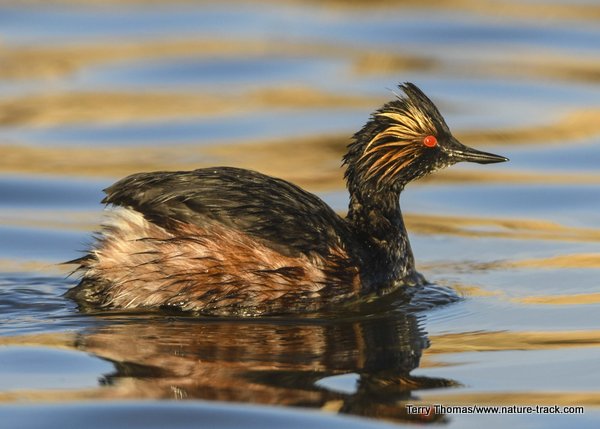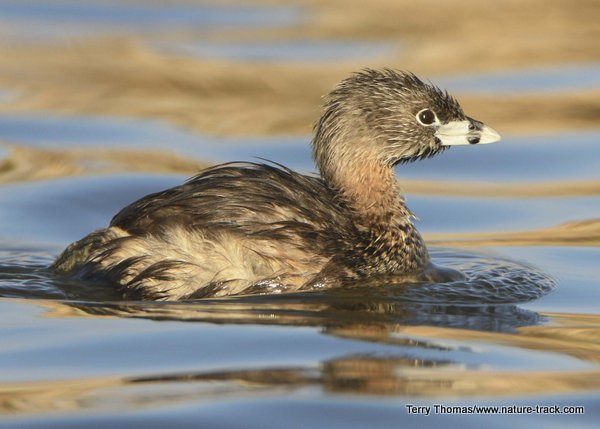Grebes


Although an eared grebe (left) and a pied-bill grebe don’t look much alike they are members of the same family and share many traits.
There are some birds that are a joy to watch because they are easy to find. There are others that mesmerize with their beauty. Still others enthrall us with curious behaviors. I like the grebes, as a group, because between them, they do all three.
Grebes are unique in many ways. Their order contains a single family, the Podicipedidae, with six genera and 22 species. These species are spread across the globe on every continent except Antarctica. In our area, we have five species: Pied-billed, Western, Clark’s, eared and red-necked grebes, representing three genera. We also have the potential to see a migrating horned grebe. While mostly freshwater species, there are some that occur in marine habitats.
With 22 species spread across the planet, it is reasonable to assume that there is a wide variety in looks, size and behaviors. That is certainly the case here. Grebes range in size from the diminutive least grebe that weighs in at 4.3 ounces to the great grebe which is nearly 15 times larger, weighing 3.8 pounds. Bills vary from long and pointy to short and stout, depending on foraging technique and preferred foods (insects, small fish, crustaceans and other invertebrates).
There are unifying characteristics as well. Grebes have lobed toes (not webbed), which is like having a swimming flipper on each of their three front toes, and are excellent swimmers and divers. They swim with feet thrusting together, much like a frog. They swim far better than they walk and are often reluctant to fly (although all of our species do migrate) choosing instead to dive and swim away from danger.
Grebes usually dive head first with a little hop from the surface of the water. However, I have watched them slowly sink below the surface, something I have never seen another bird do. This is because they have unusually dense and waterproof plumage. They can adjust buoyancy by pressing the feathers against the body. The closer to the body they hold the feathers, the less buoyant they are.
Speaking of feathers, one of the most interesting things about grebes is that they eat their own feathers and feed them to their young. These feathers form two balls in the stomach of the bird. Scientists still have not unraveled the purpose of these feather balls.
While in non-breeding plumage, grebes are generally pretty drab. During breeding season though, they can be strikingly handsome. Most of this centers around the head where crown and facial feathers can be raised up in some stunning displays. Many grebes, such as the horned and eared grebes, also have some sort of chestnut coloration on the head, making for some stunning contrasts.
If you do an internet search on courtship rituals among grebes, you will find hundreds of examples of the same three species: Western and Clark’s grebes and the great crested grebe of Eurasia, India and Australia. While most grebes have fascinating rituals that include gifting aquatic vegetation, a lot of vocalization, head bobbing and intimate gestures, the Western and Clark’s and the great crested grebe take it to a new level. Their paired dances impress not only themselves, but anyone else watching as they sprint across the water surface together in what seems to be a choreographed performance.
Grebes carry this intimate behavior into parenting. Although the chicks are precocial and able to swim at birth, they often catch a ride on one of their parent’s backs while the other parent hunts and feeds them atop their perch.
Watch for and observe grebes on your next outing and you may get to witness some of these behaviors and uncommon beauty.
Help Idaho Wildlife
When we traveled across the state in October 2017, we visited most of the Idaho Department of Fish and Game wildlife management areas. Most of the vehicles we saw using the wildlife management areas did not have wildlife plates. Buying wildlife plates is a great way for non-hunters and hunters alike to support wildlife-based recreation like birding.
C'mon folks, let's help Idaho's wildlife by proudly buying and displaying a wildlife license plate on each of our vehicles!
See below for information on Idaho plates. Most states have wildlife plates so if you live outside Idaho, check with your state's wildlife department or vehicle licensing division for availability of state wildlife plates where you live.
And tell them that you heard about it from Nature-track.com!

Wildlife License Plates
Great news! as of 2024, there are three NEW designs for license plates. They still are bluebird, cutthroat trout and elk, but they are beautiful.
Idaho Wildlife license plates provide essential funding that benefits the great diversity of native plants and wildlife that are not hunted, fished or trapped—over 10,000 species or 98% of Idaho’s species diversity. Game species that share the same habitats (such as elk, deer, antelope, sage-grouse, salmon, trout) also benefit from these specialty plates.
No state tax dollars are provided for wildlife diversity, conservation education and recreation programs. Neither are any revenues from the sale of hunting or fishing licenses spent on nongame species. Instead, these species depend on direct donations, federal grants, fundraising initiatives—and the Idaho Wildlife license plates.
Both my vehicles have Bluebird Plates. I prefer the bluebird because the nongame program gets 70 percent of the money from bluebird plates, but only 60 percent of the money from elk and trout plates - 10 percent of the money from elk plates supports wildlife disease monitoring and testing programs (to benefit the livestock industry) and 10 percent from cutthroat plates supports non-motorized boat access.
Incidentally, in 2014, the Idaho Legislature denied the Department of Fish and Game the ability to add new plates or even to change the name of the elk and cutthroat plates (very specific) to wildlife and fish plates, a move that would have allowed for changing images occasionally and generating more revenue. It would seem that they believe that we Idahoans don't want a well funded wildlife program.
I think it is time we let the Legislature know that Idahoan support wildlife funding and that we would like to see these generic plates come to fruition.

"WOW. What a phenomenal piece you wrote. You are amazing." Jennifer Jackson
That is embarrassing, but actually a fairly typical response to my nature essays. Since The Best of Nature is created from the very best of 16 years of these nature essays published weekly in the Idaho Falls Post Register (online readership 70,000), it is a fine read. It covers a wide variety of topics including humorous glimpses of nature, philosophy, natural history, and conservation. Readers praise the style, breadth of subject matter and my ability to communicate complex and emotional topics in a relaxed and understandable manner.
Everyone can find something to love in this book. From teenagers to octogenarians, from the coffee shop to the school room, these nature essays are widely read and enjoyed.
Some of the essays here are my personal favorites, others seemed to strike a chord with readers. Most have an important message or lesson that will resonate with you. They are written with a goal to simultaneously entertain and educate about the wonderful workings of nature. Some will make you laugh out loud and others will bring a tear to the eye and warm your heart.
Readers Write:
"You hit a home run with your article on, Big Questions in Nature. It should be required reading for everyone who has lost touch with nature...great job!" Joe Chapman
"We enjoyed your column, Bloom Where Planted. Some of the best writing yet. The Post Register is fortunate to have your weekly columns." Lou Griffin.
To read more and to order a copy, click here or get the Kindle version
Copies are also available at:
Post Register
Island Park Builders Supply (upstairs)
Barnes and Noble in Idaho Falls
Harriman State Park, Island Park
Museum of Idaho
Valley Books, Jackson Wyoming
Avocet Corner Bookstore, Bear River National Wildlife Refuge, Brigham City, Utah
Craters of the Moon National Monument Bookstore, Arco, Idaho